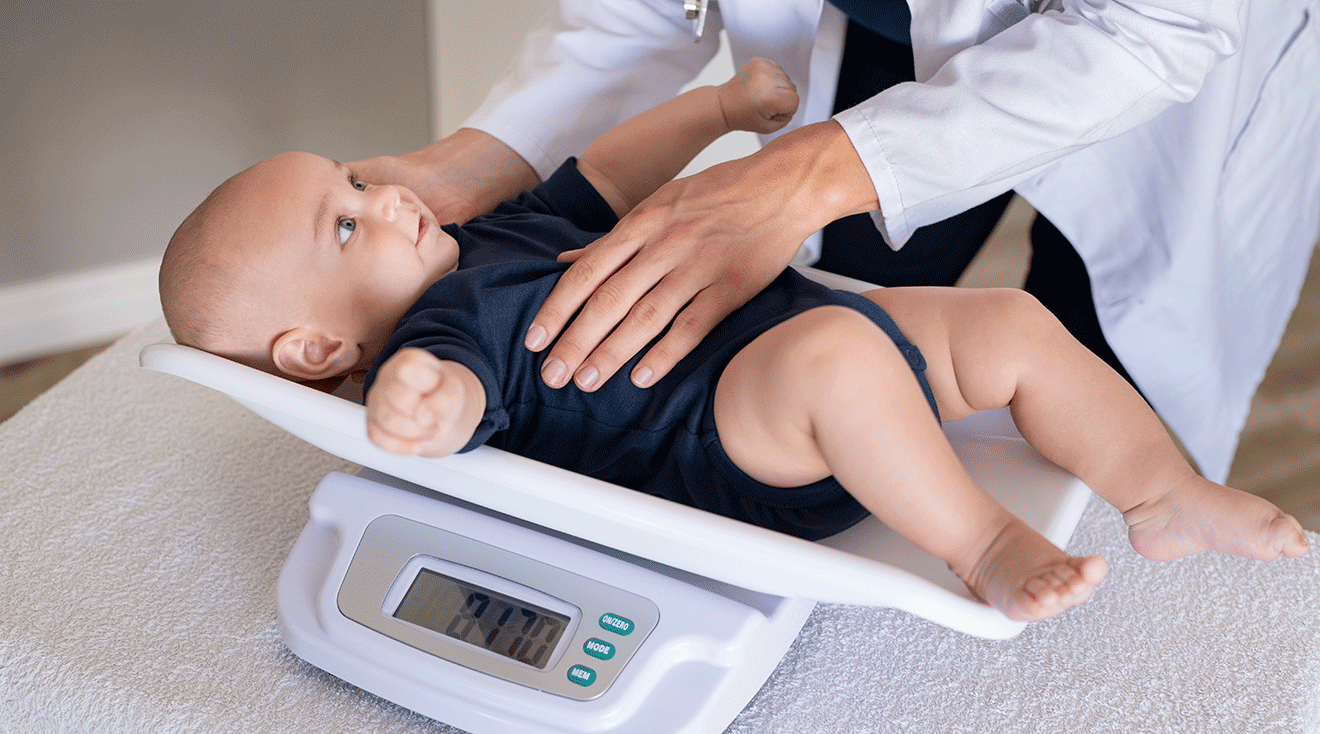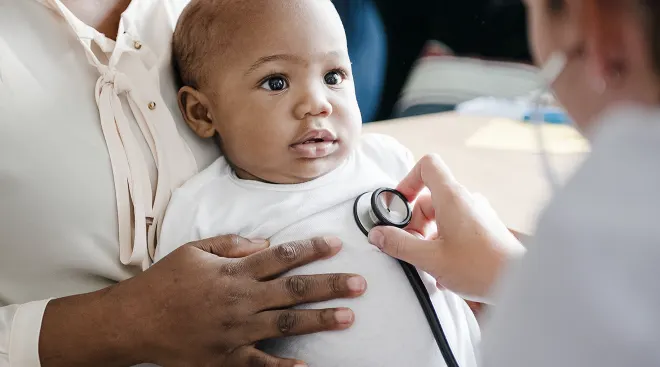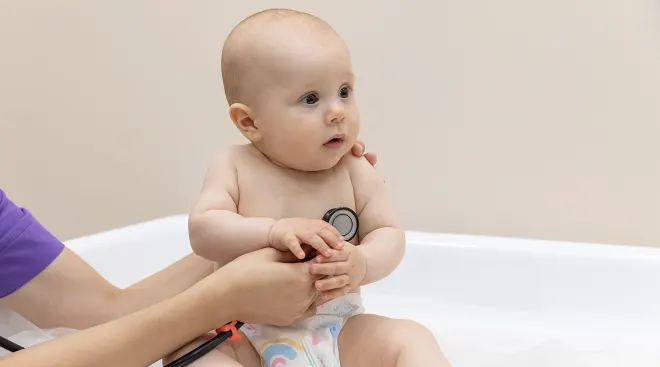Everything to Know About Baby Percentiles
Baby percentiles are key markers in baby’s development. But it can get tricky to keep up—and to decipher what baby’s percentile means. Unlike with test scores, higher baby growth percentiles aren’t better (or worse) than lower ones. So how can you know if your child is on the right growth path? And can you calculate baby’s percentile yourself? Read on to learn from experts all the information you need to know about baby percentiles and what they really mean.
What does percentile mean for babies? Baby percentiles are really just a tool pediatricians use to track baby’s growth. Per Britannica, a percentile shows the numeric position of a data point within a dataset. In terms of baby’s growth and growth charts, percentiles show you how baby’s measurements—specifically their height, weight, head circumference and BMI—compare to other babies of the same age, explains Denise Scott, MD, an Oklahoma-based pediatrician and pediatric endocrinologist. For example, if baby measures in the 95th percentile for their weight, what it really means is that they weigh more than 95 percent of other babies their age, but 5 percent of babies weigh more than them. Usually in percentiles, if baby is measuring on the lower end, it means they’re on the smaller side, while measuring on the higher end means they’re on the bigger side.
When discussing baby growth percentiles, you might hear the following terms: weight for age percentile, length for age percentile, head circumference percentile and weight for length percentile. But what do these mean? “All of these measurements are plotted and compared on standardized charts to babies of the same age worldwide,” Scott explains. “For example, if an infant plots at the 50th percentile in weight for age, this means that half of babies their same age weigh more and half weigh less than they do…The weight for length percentile shows whether a baby’s weight is considered high or low for their given length, or whether they’re at similar percentiles in length and weight.”
Ultimately, there isn’t a black-and-white answer here, as “normal” will vary quite a bit from baby to baby based on personal factors. “There’s a wide range of what’s considered a normal weight or length for an infant,” Scott says, as anywhere from the 5th to the 95th percentile is considered within a normal range. More than the actual measurements, baby’s provider is more interested in them “growing along their curve,” adds Dyan Hes, MD, a pediatrician based in New York City with over a decade of experience.
Still, you might wonder if certain measurements, like height and weight, should fall into the same baby percentiles. Scott says they can if baby is very proportional, but it’s not an issue if they don’t. “There are many factors that determine this—family genetics, maternal size, nutritional status during pregnancy, infant feeding method, etc. Some babies are long and lean and others chubby, and all can be normal for their family,” she explains. Similarly, if baby is below or above the 50th percentile for height and weight, it just means they’re above or below the average compared to other babies their age—but remember this isn’t a bad thing.
Why boys and girls have separate baby percentile charts
“Boys, in utero, already have higher metabolic demands than girls,” explains Blair Hammond, MD, assistant professor of pediatrics at Mount Sinai Hospital in New York City. As a result, even after birth, they continue to grow differently. However, biological sex isn’t the only factor when considering baby growth percentiles—certain genetic conditions, like Down syndrome, can also affect infant percentile. With different growth curves, there are different expectations for the child’s size, Hammond says.
While many parents wonder how to calculate their child’s baby percentile, no one actually has to do any math, including your doctor. That’s because the World Health Organization (WHO) and the Centers for Disease Control and Prevention (CDC) have already done the hard work for everyone. (These growth charts have been used since 1977, though the WHO updated its charts in 2006 based on the data collected from children in six countries, including the US.) According to the American Academy of Pediatrics (AAP), children under 2 should have their baby percentile charted according to the WHO growth charts. After 2, they can be plotted using the CDC growth charts. (For more information on the different growth charts, read more here).
What this means is your pediatrician simply takes your child’s height, weight and head circumference measurements and plots them on the appropriate chart. Depending on where those numbers fall, they’ll arrive at your baby percentile. The numbers are more of a reflection of what’s in line with your family genes and, when compared to baby’s score from a previous checkup, how they’re growing. For example, sudden changes in an infant’s weight percentile could indicate underfeeding or overfeeding. But as the CDC reminds us: “Growth charts are not intended to be used as a sole diagnostic instrument.” Rather, they’re helpful tools that contribute to your child’s overall picture of health.
If you’re curious and want to calculate baby’s percentile, Scott notes there are online calculators that allow you to plug in the baby’s measurements and will calculate the respective percentile or plot baby’s growth chart. Keep in mind, the most accurate way to assess baby’s growth is by talking to your pediatrician.
As long as you make sure baby doesn’t miss their checkups, your pediatrician can let you know if there’s a concern and if baby needs to be brought in more frequently. “It’s really about being vigilant,” Hes says. By tracking baby’s progress on the chart, the provider is able to tell if baby’s falling off their curve. For instance, “if the child isn’t growing well, if the baby’s head isn’t growing in the correct way—because that affects brain growth—or if their linear growth isn’t improving,” Hes explains. When something seems off, the doctor can ask questions that help provide clues for putting baby back on a healthy path. The pediatrician might ask about baby’s diet, if they’re having trouble feeding or if they’ve been sick.
Scott also stresses that it’s not about baby’s specific measurements at any given time, but rather more about their overall growth trends over a period of time. If baby’s growth percentiles do show changes, it will usually happen slowly rather than suddenly. “If there’s a significant slowing of growth, this can be a sign that there’s a nutritional problem, such as not getting enough calories, or an infant not absorbing the calories as they should or possibly a chronic illness,” she says. “There are numerous reasons why a baby may not grow as expected and the growth chart is a tool to help the doctor monitor and investigate.”
Frequently Asked Questions
How do sleep and diet affect baby’s growth?
Babies grow most during their sleep, Scott says, so if they’re not sleeping well or enough, this will interfere with their growth. Nutrition is likewise important because babies need a certain amount of calories to put on weight and ensure they’re following an average growth rate.
Will a premature baby catch up to average weight and height percentiles?
“Most babies born either prematurely, or those born small for gestational age (SGA), will eventually catch up in their growth and be on the full-term growth chart,” Scott says. Until they do, however, she says growth charts made specifically for premature babies should be used to more accurately track growth and development. “The growth in these infants may be slower so standards have been established for these babies.” As for when premature babies may catch up, she says to allow up to 2 years, though some babies may catch up more quickly. “Most important is that the baby is tracking consistently in their growth and not falling further behind.”
Is it worrisome if baby has a bigger head than average?
According to Scott, baby’s head should be proportional to their other growth measurements. Larger babies will have bigger heads, and usually this occurs due to familial genetics. “However, the trend in head growth over time is what is followed,” she says. If baby’s head grows much quicker than the rest of their measurements and crosses percentiles, then, yes, it could be cause for concern, indicating issues with skull and brain growth. Your doctor will want to do further evaluations.
As a parent, you want to ensure baby’s growth and development is on track, but rest assured that the numbers of baby’s percentiles don’t matter as much as you might think. As long as baby is getting their rest, feeding well and has lots of opportunities to play, they’ll be just fine.
Please note: The Bump and the materials and information it contains are not intended to, and do not constitute, medical or other health advice or diagnosis and should not be used as such. You should always consult with a qualified physician or health professional about your specific circumstances.
Blair Hammond, MD, is an assistant professor of pediatrics at Mount Sinai Hospital in New York City. She earned her medical degree from Dartmouth Hitchcock Medical Center and completed her residency at Icahn School of Medicine at Mount Sinai.
Dyan Hes, MD, is a pediatrician based in New York City with over a decade of experience. Currently, she serves as director of pediatrics at Concorde Medical Group. She earned her medical degree from University of Tel Aviv, Sackler School of Medicine and completed her residency at Montefiore Medical Center in New York City.
Denise Scott, MD, is a pediatrician with JustAnswer and a pediatric endocrinologist based in Oklahoma with over 30 years of experience. Certified in culinary medicine, Scott also runs the blog Feed Future Health and is the author of Feed Your Child's Future Health: Prevent Disease Before it Starts. She received her medical degree from the University of Texas Medical Branch and completed her residency at the University of Oklahoma Health Sciences Center with a fellowship at the National Institutes of Health.
Britannica, Percentile
American Academy of Pediatrics, WHO Growth Chart
Centers For Disease Control and Prevention, WHO Growth Standards Are Recommended for Use in the U.S. for Infants and Children 0 to 2 Years of Age, September 2010
Centers For Disease Control and Prevention, What Growth Charts Are Recommended?, June 2017
Learn how we ensure the accuracy of our content through our editorial and medical review process.
Navigate forward to interact with the calendar and select a date. Press the question mark key to get the keyboard shortcuts for changing dates.




















































